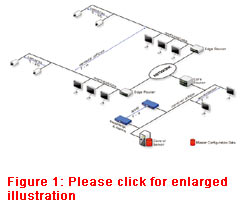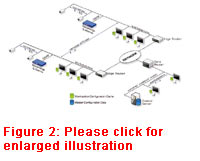This article discusses the scalability problems which arise when an IP video surveillance system is based on centralized architecture, and how distributed architecture delivers a flexible and scalable solution that can lead to systems being deployed across sites, cities and countries.
This article discusses the scalability problems which arise when an IP video surveillance system is based on centralized architecture, and how distributed architecture delivers a flexible and scalable solution that can lead to systems being deployed across sites, cities and countries.
Storing IP Video Data
There are typically two different approaches to storing data. A centralized architecture uses a master database located in a central control room. A distributed architecture spreads the data around the system, generally keeping it close to where it is produced or needed. The stored data can be categorized into two types: configuration and live.
Configuration data is site information specifying the design and makeup of the video surveillance system, including lists of cameras, lists of users, user permissions, site structure, maps representing the layout of the system and licensing information. After the initial installation and commissioning stages of a system is in place, configuration data is not routinely changed. It is however routinely accessed by operators, for example when logging onto the system.
In centralized architecture, storing is not limited to configuration data, but includes live data as well, such as video recordings or alarm data.
Centralized Architecture
Figure 1 shows a video surveillance system consisting of one or more sites, each with its own Local Area Network (LAN) connected to a central office.
Every camera and workstation in each remote office must regularly, and in some cases continuously, communicate with the central office in order to check for changes and updates in the site database. This includes checking for valid licenses, storing recording and alarm data.
Centralized architecture causes four major problems listed below.
· Cost: All users continuously communicate with the central office. On a LAN that means buying expensive high-end switches and on a Wide Area Network (WAN) it means using up precious bandwidth.
· Reliability and resilience: If the WAN or core LAN switch breaks, remote users are left stranded with no access to the live and recorded video from cameras which are actually located locally on a working LAN.
· Single point-of-failure: All users of the system rely on access to the site database for login credential verification or license permission checks. If the site database server fails, the entire system fails.
· Scalability: As more cameras and users are added to each remote office and as more remote offices are added to the network, everything becomes congested. The local LANs, WAN links and central servers then need to cope with increasing levels of traffic checking for site database changes, valid licensing and storing recordings, and alarms.
 Distributed Architecture
Distributed Architecture
Figure 2 shows how the same video surveillance network can be constructed using distributed databases.
Distributing Configuration Data
To distribute configuration data, each remote workstation can keep a local cache of the site database. Information can be synchronized between the central server and remote workstations, either according to a managed schedule or on demand when a change happens. In the event that the central server, a core LAN switch or the WAN fails, users at workstations can continue to work using their locally cached site database.
Distributing Licensing Data
Rather than holding licence information in the central server, individual components of the IP video surveillance system can hold their own licenses. For example, cameras can hold information in their onboard memory about allowed viewing and recording resolutions, or allowed frame rates. They can also hold information on enabling features such as advanced motion analytics.
Such a model, where sources of the valuable data (cameras and recorders) contain their own licences, means that cameras and recorders never need to talk to the central server. This frees up data viewing applications, running on each workstation, from requiring any license at all, and none of the workstations need to check licensing conditions with the central server. An operator, thus, cannot view video if the camera or recorder will not let him.
 Distributing Live Data
Distributing Live Data
Rather than continuously streaming recording and alarm data back from the remote sites to the central site across the WAN, it is more practical to keep the data locally on the LAN. One or more local NVRs at each remote site would reduce traffic across the WAN and allow users at remote sites to access recordings and alarms even when the WAN is not available.
As less then 0.1 percent of video gets recovered and viewed, it is prudent to use the WAN to restore the pertinent recorded video data when required.
Solving the Problems of a Centralized Architecture
The four major problems associated with a centralized architecture are overcome with distributed architecture.
· Cost: WAN bandwidth is not used for continuous communication with all remote devices. Instead, configuration data is distributed in a managed way. In the event of an operational incident, only the live video that is required needs be streamed across the WAN or extended LAN. The need to check license data across the network is removed entirely. Cost-effective core network switches can be specified to cope with reduced network loads.
· Reliability and resilience: A potential source of failure in the network is the WAN. Money can be spent to increase the reliability of the WAN connections but it is more effective to distribute the data so that users still have a working system if the connections fail.
 · Single point-of-failure: Data stores are vulnerable in IP video surveillance systems – either at the central server hosting the site database or at the recorders. With distribution of data stores, users still have a working system if these components fail.
· Single point-of-failure: Data stores are vulnerable in IP video surveillance systems – either at the central server hosting the site database or at the recorders. With distribution of data stores, users still have a working system if these components fail.
· Scalability: With distributed architecture, additional cameras and users can be added to a local office with minimal increase in WAN traffic. For even larger systems, multiple central servers can be distributed and synchronized, adding yet another layer of distribution and resilience.
Enterprise IP Video Surveillance Systems
A distributed architecture is a fundamental requirement for large enterprise systems with thousands of cameras spread across many locations. Sometimes these locations will be geographically dispersed across sites, cities or even countries, such as a large corporations, city surveillance, rail networks or road systems. Other times there may be one large location with a high density of cameras split into different groups of cameras, such as casinos or airports.
System designers and end users should ensure that their systems are distributed solutions, otherwise the lack of scalability may hinder future expansion and a single point-of-failure could lead to unreliable operations.